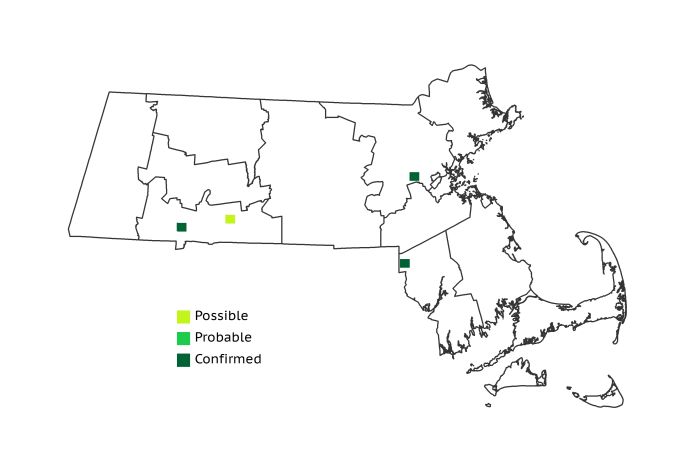Breeding Bird Atlases (BBA)
Find a Bird
Red-bellied Woodpecker
Melanerpes carolinus

Very widespread and strongly increasing
“The red-bellied woodpecker is the familiar zebra-backed woodpecker of eastern woodlands and towns.” – Jonathan Alderfer, National Geographic Complete Birds of North America
The Red-bellied Woodpecker’s bright red cap and nape make the pale rosy wash for which the species is named seem drab in comparison. Before the beginning of the first Massachusetts Breeding Bird Atlas project, Red-bellied Woodpeckers were nothing more than rare vagrants in the Bay State. As the project progressed, they began nesting in the state, eventually proving to be veritable dynamos. By Atlas 2 they were as widespread in Massachusetts as they apparently were in days of yore. Today Red-bellied Woodpeckers are a characteristic species of open second-growth woods at lower elevations throughout most of the state.
Historic Status
During the 1830s, it was possible to see a Red-bellied Woodpecker in Massachusetts but only in the western part of the state (Peabody 1839). In his 1839 report, William Peabody speculated, “They were doubtless common in Massachusetts, some years ago; but as they gradually withdraw before the settlements, they will disappear as the forests are cut down; a consummation, which is quite as near at hand, as the friend of civilization could desire.” Scattered sightings over the next half century – in Springfield in 1863, Newton in 1880, Cohasset in 1881, and Clinton in 1896 (Howe & Allen 1901) – kept hope alive that the species might someday once again inhabit Massachusetts. Forbush called it a “mere straggler” throughout New England (Forbush 1927), but as the twentieth century rolled forward reforestation was well on its way throughout much of the region. By the mid-1960s, Red-bellied Woodpeckers were nesting in southeastern New York State and in 1971 they nested in Connecticut (Petersen & Meservey 2003).
Atlas 1 Distribution
As their specific epithet carolinus suggests, breeding Red-bellied Woodpeckers were still mostly concentrated in the southern states during Atlas 1. The Connecticut River Valley, which accounted for 50% of all Atlas 1 sightings with its whopping total of 2 occupied blocks, was ground zero for this species’ colonization of the state. Another breeding Confirmation was in the Bristol/Narragansett Lowlands, just over the border from Rhode Island, and the last occupied block was situated among the well-watched yards of the Boston Basin. This was a prescient indicator of the Red-bellied Woodpecker’s future as a widespread and abundant backyard bird.
Atlas 2 Distribution and Change
Other than the Wild Turkey (which received considerable direct assistance from humans), no breeding bird species in Massachusetts shows a greater increase in occupied blocks across the state than the Red-bellied Woodpecker. Red-bellied Woodpeckers seem to have flooded into the low-lying areas of the state from the south. Worth noting is the species’ thinner distribution in some of our higher ecoregions, namely the Berkshire Highlands, Lower Berkshire Hills, and the Worcester Plateau. Though they have definitely expanded northward, Red-bellied Woodpeckers appear to be lowland birds at heart. While Red-bellied Woodpeckers were not yet ubiquitous in the Bristol/Narragansett Lowlands or Cape Cod and Islands at the end of Atlas 2, they seemed on their way to becoming so, especially with Confirmed breeding as far afield as Nantucket.
Atlas 1 Map

Atlas 2 Map

Atlas Change Map

Ecoregion Data
Atlas 1 | Atlas 2 | Change | ||||||
Ecoregion | # Blocks | % Blocks | % of Range | # Blocks | % Blocks | % of Range | Change in # Blocks | Change in % Blocks |
Taconic Mountains | 0 | 0.0 | 0.0 | 14 | 56.0 | 1.8 | 10 | 66.7 |
Marble Valleys/Housatonic Valley | 0 | 0.0 | 0.0 | 32 | 82.1 | 4.1 | 32 | 82.1 |
Berkshire Highlands | 0 | 0.0 | 0.0 | 18 | 32.7 | 2.3 | 17 | 32.1 |
Lower Berkshire Hills | 0 | 0.0 | 0.0 | 12 | 38.7 | 1.5 | 11 | 40.7 |
Vermont Piedmont | 0 | 0.0 | 0.0 | 16 | 94.1 | 2.0 | 11 | 91.7 |
Berkshire Transition | 0 | 0.0 | 0.0 | 25 | 62.5 | 3.2 | 19 | 61.3 |
Connecticut River Valley | 2 | 3.6 | 50.0 | 63 | 96.9 | 8.0 | 46 | 95.8 |
Worcester Plateau | 0 | 0.0 | 0.0 | 60 | 68.2 | 7.7 | 32 | 66.7 |
Lower Worcester Plateau | 0 | 0.0 | 0.0 | 70 | 87.5 | 8.9 | 45 | 83.3 |
S. New England Coastal Plains and Hills | 0 | 0.0 | 0.0 | 262 | 92.6 | 33.5 | 214 | 94.7 |
Boston Basin | 1 | 1.8 | 25.0 | 41 | 73.2 | 5.2 | 40 | 72.7 |
Bristol and Narragansett Lowlands | 1 | 0.9 | 25.0 | 88 | 77.2 | 11.2 | 81 | 80.2 |
Cape Cod and Islands | 0 | 0.0 | 0.0 | 82 | 56.9 | 10.5 | 71 | 59.2 |
Statewide Total | 4 | 0.4 | 100.0 | 783 | 75.5 | 100.0 | 629 | 75.9 |
Notes
In accordance with Atlas increases, the Red-bellied Woodpecker shows significant increasing Breeding Bird Survey trends in the New England/Mid-Atlantic Region and in the Eastern US overall.



